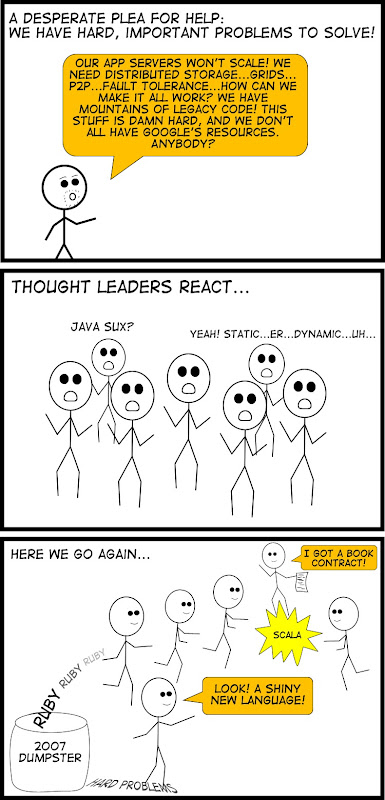Two interesting blogs inspired this post. First, there is
the amazing analysis of the great Neal Gafter. And then there is
the insightful rant of Rick Hightower.
I have to admit that I am getting on the Scala bandwagon. Here is why I think Scala is important. Note, most of this is just me ripping off Neal Gafter :-)
There is great potential in languages with control abstraction. Scala is just such a language. It is
possible to implement the actor model, a shared nothing, message based design for parallel computing, in Scala. This is not possible in Java. You can do it in Groovy, sort of, but it can be awkward. The reason for this is simple. If you have a object call method call closure (for example) the closure can return control back to the object in Scala, but only to the method in Groovy. The extra control structure coupling in Groovy makes some aspects of control abstraction awkward at best.
And then there are pattern matching (no not regexp) and case classes... The point is that there are syntactical advantages in Scala that make it possible to handle concurrent programming in a completely different, more scalable way. So it is not just about lines of code and what not, it is about being to do practical things in a better way.
Now Rick's main point in his rant, is why invest in JRuby and Scala when there is Groovy. Hopefully I've given at least one reason why Scala has potential that Groovy does not. When it comes to Ruby, the answer is less technical and more social.
On the technical side, it is very conceivable that by the end of the 2008, the absolute best way to deploy a Rails application will be to use JRuby. That is partially because of the current state of native Ruby interpreters, but also just because of how powerful the JVM has become. Sun really wants this to be the case, and here is why.
Sun knows what it takes to introduce a new language and platform and make it the de facto standard in the industry. It is very hard and expensive. They have done it once, and it cost them dearly. Java cannot stay at the top forever. They do not want to fight this battle again. However, if they can get the Rails on JRuby scenario described above to exist, then they could "stay on top" without having the fight all of the battles this time. They let the Rails community do it for them. They let guys like DHH and Martin Fowler win over the hearts and minds, while they simply concentrate on making JRuby run screaming fast.
But wait, there's more. Sun really wanted NetBeans to be the premiere Java development platform, but IBM beat them with Eclipse. They get a second chance if Ruby becomes the new de facto standard, and this time they have a head start on IBM. Sun is imagining a future where there are armies of IT developers writing Rails apps using NetBeans and deploying them to Glassfish.
Now all of the above may be possible, maybe even easier, with Groovy. But then they have to fight the language wars all by themselves. They have to win over the hearts and minds of developers to get them to use Groovy instead of C# or PHP.
That is why it makes more sense for Sun to back JRuby than to back Groovy.
That is also why you should not expect Sun to get behind Scala until they have no choice.




